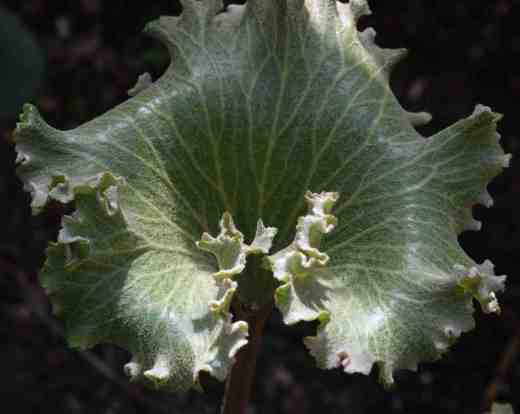Sculptural foliage? You bet!
Yesterday I blogged about an oddity that not everyone would love and I will continue the trend with another plant that is grown primarily for its leaves. Farfugium japonicum is an odd plant with creeping, rhizomatous stems and large, circular leaves that are usually bright green and evergreen. In late summer it produces tall stems of yellow, daisy-like flowers. It is from Japan but most common in Europe in frost-free climates where it is evergreen and vigorous, making ground cover about 45cm high. It is very attractive and desirable. It is on the borderline of hardiness in the UK and Ireland though it may lose its leaves in winter. It makes a great plant for a patio pot. The most commonly seen form is ‘Aureo-maculata’ which has yellow spots on the leaves which look, to me, as though it is recovering from an accidental dose of glyphosate. But I am in the minority because the common name for the plant is leopard plant which must surely be because of this cultivar.
But the apple of my eye (today) is ‘Crispatum’ which is weird and wonderful. The leaves are up to 20cm across, wavy and curled at the edges and covered in greyish hairs that lend a subtle colour to the leaves which also have a pink tinge when young. It grows best in a sheltered site in part shade with plenty of water but not wet in winter and it is superb in a pot (of John Innes compost). Alternatively combine it with hostas and ferns or some bergenias that would make up for its less than lovely appearance after a hard winter.
This is a very choice beauty that will make you very happy when it is looking its best – and devastated if it dies (like mine did many years ago). This one will be in the polytunnel this winter until it is bigger and I have the perfect spot for it in spring.
Geoff’s rating
9/10
Garden rating
7/10


This is a beauty, I will be adding it to my wish list. I agree with you on speckled leaves, they often look to me like the dog has peed on them.
You certainly have quite a collection of oddities! This one sounds nice though.
Oh I like that but I don’t like the yellow flowers. I would have to pinch them off
They are not produced much in the UK and pinching off the flowers will result in more leaves so good idea 🙂
Top tip
I think I would have rated it the other way around, with 7 and 9 instead of 9 and 7. I think it is great in other gardens, but have not been impressed with it here.
that is interesting!